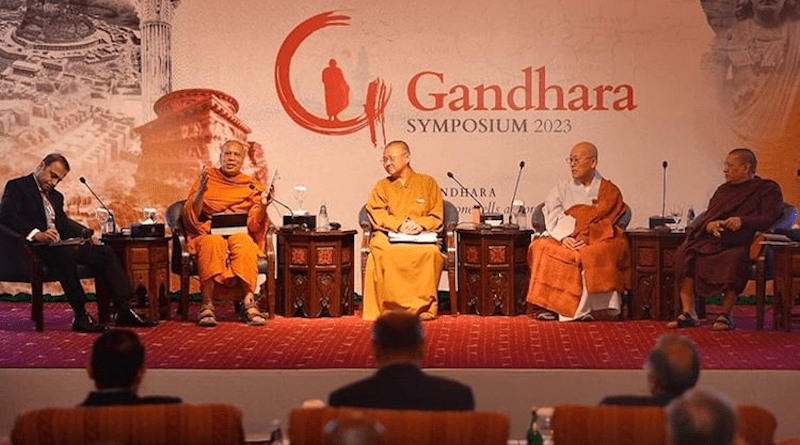Gandhara Symposium 2023: Pivotal To Promoting Interfaith Harmony In Pakistan – OpEd
The three-day Gandhara Symposium 2023, titled “Cultural Diplomacy: Reviving Gandhara Civilization and Buddhist Heritage in Pakistan”, was held in Islamabad from 11-13 July 2023. It was basically aimed to revive cultural diplomacy, promote religious harmony, and show the world the positive security landscape of Pakistan.
The president of Pakistan inaugurated the three-day symposium. In his address, Honorable President Dr. Alvi lauded the initiative and reminded the audience that “the Gandhara Civilization held immense importance for the Pakistani nation, representing a powerful dimension of our rich cultural heritage. The President emphasized that in today’s world, where hatred is on the rise and increasing polarization is fueling conflicts, it is time to rediscover the role of cultural diplomacy to promote dialogue among civilizations. He stressed that cultural diplomacy holds enormous potential to strengthen global ties. The journey to revive the glorious Gandhara civilization and Buddhist heritage in Pakistan is thus vital in this regard”.
The participation of Buddhist delegations from various countries including Malaysia, Thailand, South Korea, Nepal, Sri Lanka, and China in the conference shows the religious tolerance for other faiths in Pakistan. Faith leaders, archaeologists, curators, experts, religious scholars, and academicians reflected on the richness of Gandhara civilization and the Buddhist Heritage. According to them, Pakistan is a safe place for tourism, and this Symposium conveys the requisite message aptly. Pakistan is going to start Gandhara Tourism, and it is ready to collaborate with other countries to enhance B2B and P2P exchanges.
Gandhara civilization, also known as the Gandhara culture, was an ancient civilization that flourished in the region of Gandhara, located in present-day northern Pakistan and eastern Afghanistan. It developed from around the 6th century BCE to the 5th century CE and was influenced by various cultures, including Greek, Persian, Central Asian, and Indian. The Gandhara civilization was situated at a crossroads of trade routes and became a melting pot of diverse cultural influences. It played a significant role in the spread of Buddhism in the region, and its art and architecture reflect this influence. The Gandhara region was ruled by various dynasties, including the Persian Achaemenid Empire, the Maurya Empire of India, the Greco-Bactrian Kingdom, the Indo-Greek Kingdoms, the Indo-Parthians, and the Kushan Empire. These ruling powers left their mark on the culture and art of Gandhara.
Gandharan art is particularly famous and distinctive. It blended elements of Greek, Persian, and Indian styles, resulting in a unique artistic tradition. Gandharan sculptures, especially Buddha statues, were known for their realistic portrayal, with a blend of Hellenistic and Indian features. These sculptures are characterized by their graceful appearance, flowing robes, and intricate details. The decline of the Gandhara civilization can be attributed to various factors, including the collapse of the Kushan Empire, the decline of Buddhism in the region, and invasions by Central Asian tribes. By the 5th century CE, the region came under the control of the Gupta Empire in India, and Gandhara lost its political and cultural prominence. Today, the remnants of the Gandhara civilization can be seen in archaeological sites and museums in areas of Pakistan’s provinces Punjab and Khyber Pakhtunkhwa (KPK). These sites include Takht-i-Bahi (Mardan, KPK) Taxila heritage site (Punjab), and Swat heritage site (KPK). The Gandhara art and sculptures are highly valued and continue to inspire artists and researchers interested in the ancient history and culture of the region.
Pakistan, the host of the various monolithic and polytheist religions’ sacred sites, has been maintaining these sites to promote cultural ties with the countries where these religions are practiced most. Every year followers of different religions come to Pakistan to visit these religious sites. Buddhist tourists from various countries come to Pakistan to visit the Buddha Sculptures in areas of Pakistan that used to be part of the old Gandhara civilization. Pakistan is trying to revive these sites for religious tourism in the country. In 2022 a delegation of 150 Buddhist monks arrived from Thailand at Julian Stupa, a world heritage site, in Pakistan where the delegation also performed several religious rituals. Preserving and further promoting the Buddhist Gandhara heritage is of paramount importance for Pakistan in order to create a thriving environment for other religions in Pakistan. Besides other modes, digital and social media offer new powerful means for projecting the Buddhist Gandhara heritage in Pakistan to the world. The sacred sites, sculptures, and artifacts of Gandhara are not just relics from the past; they are also a source of inspiration for the faithful and tourists from different parts of the world.
One of the key objectives of the Gandhara Symposium was to create awareness about Gandhara and foster a sense of appreciation for Pakistan’s rich and diverse cultural heritage, both domestically and abroad. Another important objective of the Gandhara Symposium was to consider new initiatives that reinforce Pakistan’s cultural diplomacy efforts and help promote tourism, particularly faith tourism, in Pakistan. It highlighted that Pakistan is eager to promote religious tourism in Pakistan and to create suitable and safe environment for other religion followers.

